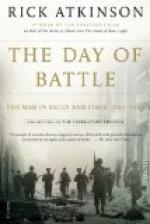Great was the indignation of the French and Belgian Zouaves. They were resolved that the same thing should not happen in Rome. That there was a chance of avoiding bloodshed may be inferred, from Count Arnim’s numerous journeys between the Vatican and General Cadorna’s headquarters outside Porta Salara; the Prussian representative hoping till the last moment to arrange matters in a pacific sense. Cardinal Antonelli is said to have been nearly persuaded, when he received a message from Colonel Charette in these terms: ’You had better go and say mass while we look after defending you.’ The war party so far carried the day that the Pope adhered to his plan of ’sufficient resistance to show that he yielded only to force.’
At half-past five on the morning of the 20th of September, all attempts at conciliation having failed, the Italian attack was opened upon five different points, Porta San Pancrazio, Porta San Giovanni Laterano, Porta San Lorenzo, Porta del Popolo and Porta Pia. General Maze de la Roche’s division attacked the latter gate, and the wall near it, in which a breach was rapidly effected by the steady fire of the Italian batteries, though it was not till past eight o’clock that it seemed large enough to admit of an assault. Then the 41st of the line, and the 12th and 34th Bersaglieri were ordered up, and dashed into the breach with the cry of ‘Savoia! Savoia!’ The challenge was returned by the Zouaves with their ‘Vive Pie Neuf.’ They had been already ordered to desist, as the Pope’s instructions were clear, ’to stop when a breach was made;’ but on the plea that the order was sent to them verbally they continued firing. When the written order came, they displayed a white handkerchief fastened to a bayonet, and at this point the fight was over. Hundreds of Roman exiles poured through the breach after the soldiers; 15,000 of them had arrived or were arriving at the gates of the city.
At the same time the white flag was hoisted on Porta Pia, but on the advance of the 40th Regiment and a battalion of Bersaglieri, shots were fired which killed and wounded several officers and men; when they saw their companions falling, the troops could not be restrained from scaling the barricade which had been formed to defend the gate, and surrounding and capturing the Zouaves who were behind it. The whole Diplomatic Corps now came out in full uniform to urge General Cadorna to effect the occupation as quickly as possible, that order might be maintained. By midday, the Italian troops had penetrated into most parts of the city left of the Tiber; as yet there was no formal capitulation on the part of the Zouaves, and their attitude was not exactly reassuring. This did not prevent the population, both men and women, from filling the streets and greeting the Italians with every sign of rejoicing. They cheered, they wept, they kissed the national flag, and the cry of Roma Capitale drowned all other cries, even as the fact it saluted closed the discords and the factions of ages.




